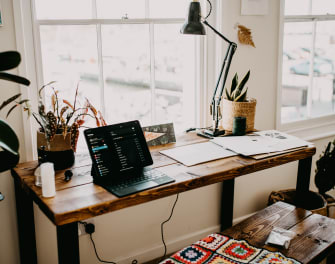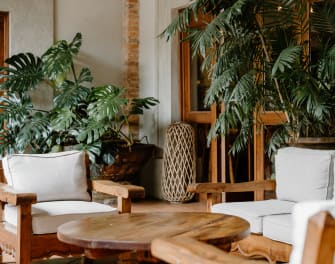Indoor plants provide plenty of benefits: from boosting air quality to reducing stress, enhancing attitude, and improving focus and productivity. By choosing indoor plant pottery that adds beauty to your home, you’ve created a true win-win situation, including (but certainly not limited to) if you now have an at-home office for remote working situations.

Fortunately, there are plenty of eye-catching indoor pots to choose from, which means you can select ones that fit your taste and décor. These include:
- Terra cotta pot: These reddish-brown pots, made out of baked clay, can add a traditional, natural look to your home. They age beautifully, taking on a lovely patina.
- Ceramic pots: These glazed pots come in a wide range of beautiful hues, shapes, and sizes, offering versatile ways to decorate your home.
- Plastic pots: These also come in a rainbow of colors, sizes, and shapes, and can be designed to mimic terra cotta, concrete, and other materials.
- Fiberglass pots: This is another kind of indoor pottery that can have the appearance of other materials: from stone to wood and more.
- Wood and metal pots: Fewer pots are made from these natural materials, so they can be used in unique ways in your home in traditional and contemporary ways.
- Concrete pots: Available in a range of sizes, shapes, and textures, they offer up one-of-a-kind charm with decorative patterns and styles.
Matching Indoor Pottery with the Plants
Once you’ve selected the right-sized indoor pot for your plant with appropriate drainage, then it’s time to focus on the appearance, choosing pottery that spotlights the uniqueness of the plant. Variegated plants may benefit from more subtle pot designs while a plant with shiny green leaves may look wonderful in a more intricately designed pot.
If the plant will eventually flower, consider the hues of the blooms and pick indoor pottery that will highlight its flowering beauty. Also consider the aesthetics of a pot’s size. A sturdily designed pot, for example, may not be the best choice to bring out the best in a delicate plant—and vice versa.
Matching Indoor Pottery with Home Décor
As a general tip, both the plants and the indoor pottery should complement the overall ambiance of the room. Look for ways to achieve balance in proportional ways. For example, when you want to highlight a corner of the room, a larger, more dramatic pot can achieve the desired effect. A pot intended for an end table would be smaller (although, depending upon the décor, doesn’t necessarily need to be more subtle in design).

Consider whether you’re looking for a more monochromatic effect or using the pots for a startling contrast. If going the first route, a light gray room may benefit from a dark gray pot with green and gray variegated plant leaves. If using the opposite approach, a glossy red pot can be quite stunning.
If your home has a rustic decorating scheme, you might want to use terra cotta or stoneware. More sophisticated decorating might lend itself well to porcelain while contemporary ones might work well with metal and concrete. That said, you may want to go against expectations in your home’s décor, and the use of indoor plant pottery is an inexpensive way to do exactly that.
Designs can be symmetrical or asymmetrical, again depending upon your intent and taste. Lines can be sharply horizontal and vertical, gently diagonal, or dramatically curved. Each evokes a different mood. You may decide to put a square pot in a boxy area and round ones in places where there are architectural arches in a room. Consider where and how you want to draw the eye of someone entering your room and place pots accordingly.
As plants grow, they often need to be repotted. At that point, you get another opportunity to change or freshen up your decor.
Tips for Repotting Indoor Plants
Using guidance from Decker’s Nursery experts, choose new pottery that is the right size for the plant you want to repot. In general, when repotting indoor plants that are currently in a container with a diameter of ten inches or less, boost the pot diameter by one or two inches. If the current pot is already more than ten inches in diameter, you’ll probably need to be repotting indoor plants in ones that are two or three inches larger.
Make sure you have the right potting mix and then place a ceramic shard over the new pot’s drainage hole so the soil won’t just leak right out. Fill the pot with enough mix for the root mass of the plant to exist one or two inches below the pot’s rim.
Now, put your attention towards the plant. Carefully remove it from the pot where it’s outgrown and examine the roots. Cut off any brown ones. Then, using sharp, clean scissors, make half-inch horizontal cuts all down the root ball, making them every few inches. Place the plant in its new pot, gently pushing soil around its roots. Tamp it down carefully to eliminate air pockets.
When repotting indoor plants, you can reuse your pots after thoroughly cleaning them, inside and out. Cleaning helps to prevent disease in the new plants. Then, choose plants that are well suited for this pottery, plant them, and then place them in eye-catching ways in your home.
Decker’s Nursery for Your Indoor Plant Pottery
Our friendly garden experts at Decker’s Nursery are happy to help you find the range of pots, size-wise, that will work well for your plants. Then, we can help you to brainstorm decorating ideas that will allow you to select the pots that will bring your creative vision to life.
We have a large selection of pottery choices that are sure to fit your needs. So, please stop by our retail garden shop any time we’re open. Or, contact us online or call us at (631) 261-1148. We look forward to making personal recommendations for your home décor.
